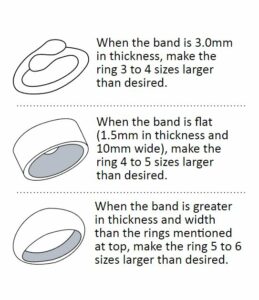Art Clay Bronze
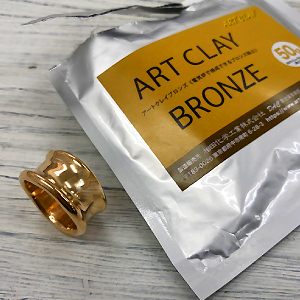
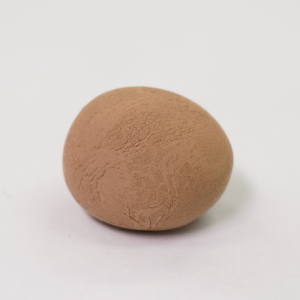
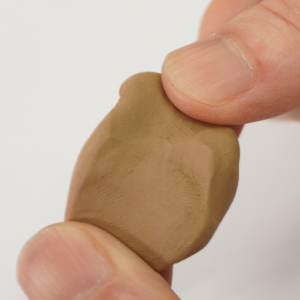
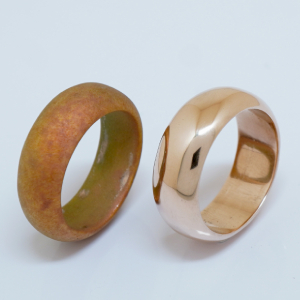
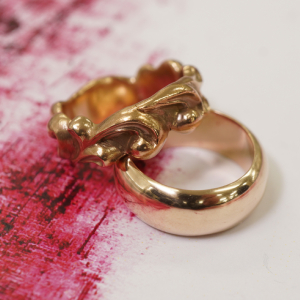
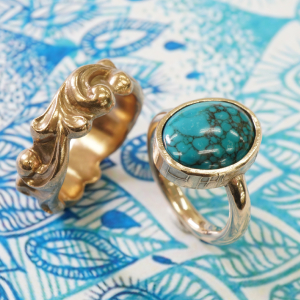
Characteristics of Art Clay Bronze
Art Clay Bronze is a clay material made from alloy powder, binder and water that you can use to make a wide range of pieces such as jewelry, craft designs, and objects like sculptures and models. Art Clay Bronze can be fired and its alloy powder fuses together in an electric kiln using carbon under reducing atmosphere, with the resulting fired piece being solid alloy (Copper 90%, Tin 10%). The percentage of alloy powder in Art Clay Bronze in the clay state is 90%.
Beautiful GOLD like color
Art Clay Bronze has been developed after testing many different metal formulas to ensure the best golden color.
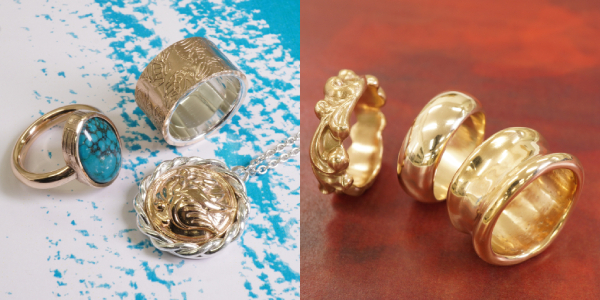
Extremely high strength as alloy
Bronze is an alloy formed with mixture of copper and tin, therefore it gives extremely high strength in both surface contact and bending pressure. Bending strength* of fired Art Clay Bronze is approx. 3 times harder than Art Clay Silver, and surface strength is approx. 2 times harder than Art Clay Silver 950.
*Bending strength is evaluated by force level in bending fired strip to 90 degrees. Higher force level means metal is harder to bend. This does not necessarily mean that Art Clay Bronze has high viscosity or density for reshaping.
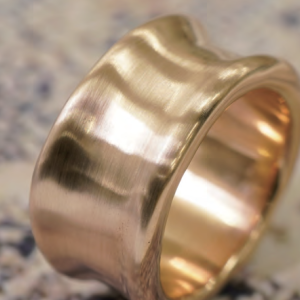
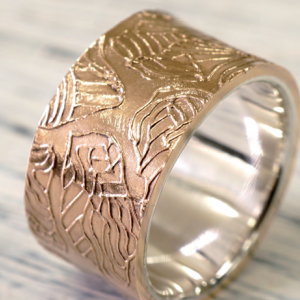
Art Clay Bronze Clay Type
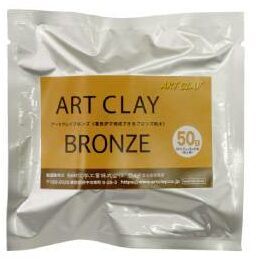
Art Clay Bronze(TM) is a clay material to make a wide range of pieces such as jewelry, craft designs, and objects like sculptures and models. Art Clay Bronze must be fired in an activated carbon under reducing atmosphere using a programmable electric kiln, with the resulting fired piece being solid alloy (Copper 90%, Tin 10%).
Copper/Tin alloy ratio in Clay state : 90 % (Rest of 10% is Binder and Water)
Shrinkage: Approx.10%-13% in length
Firing schedule: Please see the details below.
Available package:50g (2 pieces of 25g)
Material form: Lump in aluminum package.



Instructions for use

Due to the differences between Art Clay Bronze and other Art Clay series clay (ie. Art Clay Silver), the clays may contaminate each other if mixed accidentally during preparation. This can occur by using shared tools. It is therefore recommended to use separate tools for each type of clay. If this is not possible, please clean the tools carefully after each use to limit the chance of contamination.
If Art Clay Bronze and other Art Clay series clay was mixed, features and conditions for drying and firing would be changed which may break the piece. The manufacturer and sellers will not be responsible for any firing result or accident with wrong use.
Wash your hands well after using the product.
After firing in the kiln, if oxide layer was found on the piece, use pickling solution such as a powder-form pickling compound to remove it.
Follow the written instructions carefully, and do not use this product for any other purposes other than those stated in these instructions.
Do not bend the fired piece with unreasonable pressure.
Art Clay Bronze is a water-based clay, and dries naturally in the air. To avoid drying, when start molding your piece, only take out the needed amount to make your desired piece, and store well the rest of the clay using the instructions explained above. The shrinkage of Art Clay Bronze during firing is approximately 10%-13% in length, so please consider this when planning and making your piece.



Storage
Please use the product as soon as possible after opening the original product package.
After opening your package of clay, the surface of Art Clay Bronze will naturally start oxidizing and the color will darken if left in the open air. If you see a darkened surface appear, scrape off the darkened layer and use the internal clay to make your piece.
To avoid oxidation of unused clay after unsealing the original product package, please wrap in several layers of plastic wrap tightly, and then place in a zip-up type plastic bag, or an air tight container. Do not use a rubber band as it may discolor the clay.
Keep the clay indoors at a moderate room temperature and out of direct sunlight.
Drying
Dry completely after molding. The dried clay will become hard like plaster, and you can easily enjoy the process of drilling, filing and sanding with hand tools and equipment. Follow the drying instructions and drying check method below.
Clay Dryness Test
Place the dried piece on a piece of stainless or glass plate while still warm. Leave for a couple of seconds, then remove your piece from the plate. If you do not see any vapor cloud on the plate where the piece was, drying is completed.
Drying guideline for drying a piece up to 1mm thick, 5g: *If the piece is larger than this size, drying will require more time.
| Way | Time/Temperature |
|---|---|
| Hot air dryer | More than 10 mins. *1 |
| Electric Hot Plate | More than 10 mins at 150°C/ 302°F |
| Electric Kiln | More than 10 mins at 150°C/ 302°F |
| Natural Air dry method | More than 24 hrs |
*1 : Place the piece as close as safely possible to the hot air while taking care not to drop the piece.
***DO NOT dry the piece over 250°C/482°F, or the binder will be destroyed during drying and deform the shape during the firing process.***
Firing
Important check list for firing
Art Clay Bronze needs to be fired…
- In an oxygen-reducing atmosphere in an electric kiln.
Make sure to fire in a reducing atmosphere, with pieces buried in 2cm of activated carbon in a stainless steel firing pan. When possible, the pan should be on posts, and not directly on the kiln floor. Remove carbon ash and replace with fresh carbon for each firing. Enough oxygen exists to burn off the binder even while your piece is in carbon with the lid on the pan. It is recommended to use a lid on as it will contribute to a more beautiful finished color after firing. - In an adequate temperature
The firing schedule for Art Clay Bronze is 820°C for 2 hours (in carbon). However, remember each kiln is different (such as size of firing chamber, muffle vs. brick chamber walls, number of elements, front vs. toploading, etc), as well as the environments around the kiln (temperatures, humidity, altitude, etc). The digitally indicated temperature is not exactly same in every spot in the entire kiln chamber, so it is possible that different places in the chamber reach different temperatures. The most important thing is to place the firing box farthest from the kiln door because the temperature in the firing chamber near the kiln door can be much lower than the programmed temperature. - Always do a TEST FIRE first
Before making your unique projects, make a few small pieces (3cm x 1cm x 1mm) to test fire as a means of finding exactly how your kiln handles the bronze firing. Spread the pieces around in the firing pan and place the pan away from the kiln door. If your test pieces break, the firing schedule needs to be adjusted. If pieces break before bending 90°, increase the hold temperature by 10°C (up to max. 860°C).
Basic Firing Steps
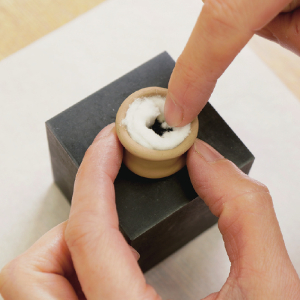
1. PREPARATION
If you fire a ring, place a circle of firing blanket along the inside band of the ring. This will avoid marks caused by carbon when the clay shrinks during firing.
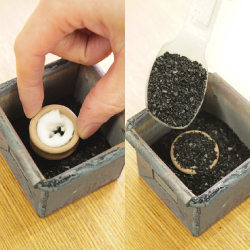
2. PREPARATION
Spread more than 1 cm of activated carbon on the bottom of a firing pan.

3. PREPARATION
Place the piece on top of the carbon layer (if you fire multiple pieces together, always have at least 2cm carbon between pieces). Bury the pieces completely under 2cm carbon.
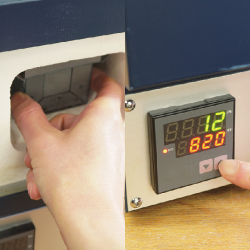
4. RAMP UP
Place the box farthest from the kiln door, and ramp up from room temperature to 820°C, taking at least 20 minutes to do so.
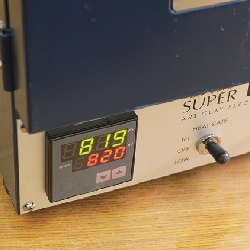
5. HOLD
Hold the kiln at 820°C for 2 hours.
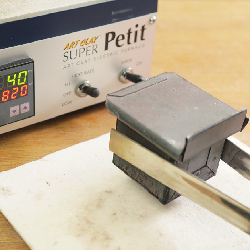
6. COOL DOWN
Allow the bronze pieces to cool to room temperature before removing from the carbon.
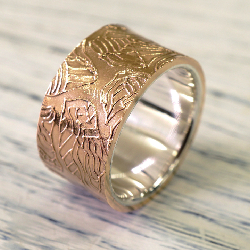
7. Finishing
After firing, the piece appears matte brown. A beautiful bronze color is revealed after polishing.
Pickling
As a character of alloy, oxide layer will be created on the surface. Have a surface polishing or use a solution made with pickling compound to remove oxide layer.
*After pickling, neutralize acid of the piece by dipping it in a baking soda mixed water (a small spoon of baking soda in a glass of water) for over 15 mins, then rinse well under running water.
*For use and proper disposal of the pickling solution, please be environmentally responsible and carefully follow the instructions of the pickling compound product.
Finishing
Warning
- This product may crack and burst during firing if insufficiently dry.
- Oxygen is consumed during firing and smoke and gas emissions may result. Please fire in a well ventilated area.
- Do not place just-fired pieces on any flammable surfaces or combustible materials as the piece will be extremely hot and could cause a fire.

Caution
- Take precautions against burns from the heated clay when drying, firing, and after firing.
- Keep out of the reach of children. If the product comes into contact with eyes or mouth, please rinse thoroughly with running water. If problems persist, please see a doctor.
- Be aware that some people are allergic to bronze. The level of reaction is different according to the individual, from light to severe. If you do have an allergy against bronze and work with and/or wear bronze accessories made from the product directly on the body, some kind of allergic reaction may occur. If in doubt, please seek medical advice from a qualified medical practitioner before use.

Frequently Asked Questions
You can use Art Clay Bronze in 2-stage firing as an option especially if you prefer to burn off binders of a thick piece, such as over 15mm thickness. Please note that it will give more strength, but also more shrinkage after firing.
(Phase 1) Open shelf firing
Place dried pieces on a fiber board, and put them in a kiln. Fire from room temperature to 450°C, then remove immediately. Let pieces cool down to room temperature. Spread at least 1 cm of activated carbon on the bottom of a firing pan. Place pieces on the carbon layer, then cover with at least 2cm more carbon. Place the pan into a kiln.
(Phase 2) Carbon firing
Ramp from room temperature to 820°C, holding 2 hours. Pieces must cool to room temperature in the carbon.
Add a small amount of water to Art Clay Bronze to make a thick paste to fill or mend the broken part. Make sure to use carbon firing after repairing.
Stones compatible with Art Clay Silver should be fine with the firing schedule of Art Clay Bronze. Test-firing stones is recommended. Compared to the open-shelf firing of Art Clay Copper, carbon firing Art Clay Bronze has a minimal chance of oxidation, therefore discoloration of synthetic stones with bronze rarely occurs.
You can fire several pieces at once as long as all pieces are buried completely in carbon. Allow 2cm carbon between pieces. Pieces touching within the carbon may result in underfiring.
Enough oxygen exists to burn off the binder even your piece is in carbon with a lid on the pan. It is recommended to have a lid on as it will contribute to a more beautiful finished color after firing.
Yes, you can pickle fired Art Clay Bronze to remove oxidation. Carbon firing will create only a very thin oxide layer on Art Clay Bronze, and you can brush/polish it off to remove it quite easily. Yes, Art Clay Bronze will discolor by oxidation as time goes by just like copper. Patina will be created on the surface exposed to high moisture or sweat. Polishing or pickling will remove oxidation or patina.
There is no big difference in drying time compared to any other Art Clay series. The strength and flexibility of Art Clay Bronze after drying is also almost the same as with other Art Clay series.
In some rare cases, there may be a possibility of reaction due to the metal. If you have allergy to copper or tin, check with your Doctor if you can work with rubber gloves or should not work with it.
When combined with other ACS series products, the clay characteristics will change. Drying and firing conditions will also vary. Therefore, it is not recommended to mix clay types as there is possibility of damage during firing.
If Art Clay Bronze contacts in high humidity, oxidation will occur. Do not add moisture to any storage case. It is recommended that you keep Art Clay Bronze tightly wrapped with plastic wrap in an airtight container.
Yes, you can use it as you would with regular Art Clay Silver. In that case, please use AIDA’s recommended empty syringe . Art Clay Bronze easily oxidizes in especially wet conditions. Make only as much syringe clay as you need, simply by adding water evenly to the bronze clay to a consistency good for syringe extruding.
The metal portion of Art Clay Bronze is 90% Copper and 10% Tin, and the organic portion is binder and water. It shrinks a little more than the regular Art Clay Silver series. For making rings, please check the shrinkage guide shown. Shrinkage after firing: Approx. 10-13%
*Note: Chart indicate Japanese sizing.
